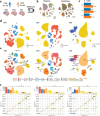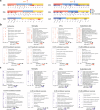This is a preprint.
Multi-omic Characterization of HIV Effects at Single Cell Level across Human Brain Regions
- PMID: 39975288
- PMCID: PMC11839123
- DOI: 10.1101/2025.02.05.636707
Multi-omic Characterization of HIV Effects at Single Cell Level across Human Brain Regions
Abstract
HIV infection exerts profound and long-lasting neurodegenerative effects on the central nervous system (CNS) that can persist despite antiretroviral therapy (ART). Here, we used single-nucleus multiome sequencing to map the transcriptomic and epigenetic landscapes of postmortem human brains from 13 healthy individuals and 20 individuals with HIV who have a history of treatment with ART. Our study spanned three distinct regions-the prefrontal cortex, insular cortex, and ventral striatum-enabling a comprehensive exploration of region-specific and cross-regional perturbations. We found widespread and persistent HIV-associated transcriptional and epigenetic alterations across multiple cell types. Detailed analyses of microglia revealed state changes marked by immune activation and metabolic dysregulation, while integrative multiomic profiling of astrocytes identified multiple subpopulations, including a reactive subpopulation unique to HIV-infected brains. These findings suggest that cells from people with HIV exhibit molecular shifts that may underlie ongoing neuroinflammation and CNS dysfunction. Furthermore, cell-cell communication analyses uncovered dysregulated and pro-inflammatory interactions among glial populations, underscoring the multifaceted and enduring impact of HIV on the brain milieu. Collectively, our comprehensive atlas of HIV-associated brain changes reveals distinct glial cell states with signatures of proinflammatory signaling and metabolic dysregulation, providing a framework for developing targeted therapies for HIV-associated neurological dysfunction.
Figures






Similar articles
-
Structured treatment interruptions (STI) in chronic unsuppressed HIV infection in adults.Cochrane Database Syst Rev. 2006 Jul 19;2006(3):CD006148. doi: 10.1002/14651858.CD006148. Cochrane Database Syst Rev. 2006. PMID: 16856117 Free PMC article.
-
Peripuberty Is a Sensitive Period for Prefrontal Parvalbumin Interneuron Activity to Impact Adult Cognitive Flexibility.Dev Neurosci. 2025;47(2):127-138. doi: 10.1159/000539584. Epub 2024 Jun 3. Dev Neurosci. 2025. PMID: 38830346 Free PMC article.
-
Behavioral interventions to reduce risk for sexual transmission of HIV among men who have sex with men.Cochrane Database Syst Rev. 2008 Jul 16;(3):CD001230. doi: 10.1002/14651858.CD001230.pub2. Cochrane Database Syst Rev. 2008. PMID: 18646068
-
Antiretrovirals for reducing the risk of mother-to-child transmission of HIV infection.Cochrane Database Syst Rev. 2011 Jul 6;(7):CD003510. doi: 10.1002/14651858.CD003510.pub3. Cochrane Database Syst Rev. 2011. PMID: 21735394
-
Comprehensive single-cell chromatin and transcriptomic profiling of peripheral immune cells in nonsegmental vitiligo.Br J Dermatol. 2025 Jun 20;193(1):115-124. doi: 10.1093/bjd/ljaf041. Br J Dermatol. 2025. PMID: 39888372
References
-
- Plaza-Jennings Amara L, Valada Aditi, O’Shea Callan, Iskhakova Marina, Hu Benxia, Javidfar Behnam, Hutta Gabriella Ben, Lambert Tova Y, Murray Jacinta, Kassim Bibi, et al. Hiv integration in the human brain is linked to microglial activation and 3d genome remodeling. Molecular cell, 82(24):4647–4663, 2022. - PMC - PubMed
Publication types
Grants and funding
LinkOut - more resources
Full Text Sources
